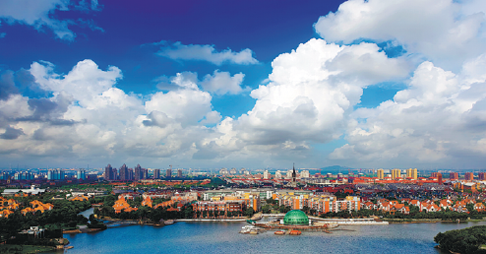New towns to boost overall growth for Shanghai

Clockwise from top: A bird's-eye view of Fengxian's Jinhai Lake. Shanghai Qingpu Industrial Park sees an influx of businesses over the last few months. The Shanghai Poly Grand Theater is a cultural landmark in Jiading. CHINA DAILY
Five areas to provide key engine for city's future development
The building of five new towns in Shanghai's suburbs, deemed key to the city's future social and economic growth, is set to create new business opportunities for both domestic and overseas investors.
In late January, Shanghai unveiled its plan to build the new towns in five suburbs, part of the city government's efforts to optimize the development layout and create new engines for future growth.
Circling out from the central area of urban Shanghai from northwest to southeast, the five suburbs are Jiading, Qingpu, Songjiang, Fengxian and the Nanhui region in Pudong New Area.
The rise of the five new towns will play a prominent part in Shanghai's 14th Five-Year Plan (2021-2025), according to experts.
The five new towns will be developed as "independent and comprehensive nodes" among the city clusters in the Yangtze River Delta region by 2025. They will provide "strategic support for Shanghai's future development", Shanghai Mayor Gong Zheng said.
So far, the construction of the five new towns is progressing steadily with around 40 major industrial projects ongoing, the city government said in early September.
Shanghai officials noted that each of the five towns will not be a traditional "satellite city", but a place with the same functions as a normal city.
In the next five years, the five towns will give full play to their own advantages and strengths. With their different positions, the new towns will become modern, ecologically friendly, convenient and vibrant places. Meanwhile, the integration of industrial development and urban life have been heavily underscored in the plan.
In the past, suburbs mainly played the role of diverting a massive flood of population density in the city's urban area, and receiving backward industries transferred from the central area, according to experts. A lack of quality industry development and less developed urban life hindered the progress of satellite cities.
In this regard, the integration of industry development and urban life is seen as an important part in the construction of the five new towns, said Chen Jie, director of Center for Housing and Urban-Rural Development at Shanghai Jiao Tong University.
Chen said more public services should be planned in the construction of new towns. Meanwhile, a favorable business environment should be created to support promising industries. This will allow the five new towns to have their own individual economic development.
According to the city's 14th Five-Year Plan and Long-Term Vision for 2035, the five new towns are projected to have a total of 3.6 million permanent residents, up from the current level of 2.5 million. By 2035, each new town will have a population of around one million.
Under the plan, major industrial projects, high-quality public infrastructure, comprehensive transportation hubs, cultural and sports facilities will be built within the next five years.
With different features and unique industrial characteristics, the administrations of the five new towns have already worked out their development plans for the next five years.
For example, new-energy, selfdriving vehicles and intelligent sensors will play a leading role in Jiading, a well-established area for automobile industry development.
Songjiang will build itself in to an innovation hub based on the regional initiative-the Yangtze River Delta G60 Science & Technology Innovation. A host of high quality industries, such as electronic information, integrated circuits, artificial intelligence and smart manufacturing will be developed.
Located close to the Hongqiao international transportation hub, which will be upgraded into Hongqiao International Hub, Qingpu will seek development in modern logistics and exhibition industries. In addition to developing the digital information industry, Qingpu, part of the demonstration zone for Yangtze River Delta integration, will also focus on environmentally friendly development.
Fengxian, which is known for the beauty and cosmetic industry cluster in the Oriental Beauty Valley, will step up efforts to become a worldclass cosmetics and health industrial hub.
Nanhui in Pudong New Area, which covers most of the Lingang Special Area of China (Shanghai) Pilot Free Trade Zone, will develop cutting-edge industries, such as integrated circuits, artificial intelligence and biomedicine.
To attract more leading industries and investors, the administrations of the five new towns will continue to craft new measures and further enhance the regional business environment.
Their updated policies include attracting talents, land planning, tax and fiscal incentives, which will help to boost the interest of global investors, officials said.

Songjiang new town accelerates creation of a favorable business environment to attract global investors. CHINA DAILY

Dishui Lake area in Nanhui new town is set to be the core business area during the 14th Five-Year Plan (2021-25). CHINA DAILY

